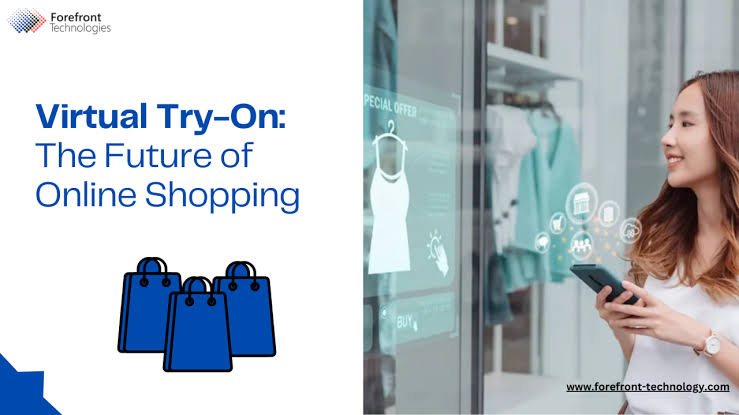In the world of online shopping, technology is continuously evolving to create better, more interactive, and personalized experiences. One of the most exciting innovations in this space is virtual try-on technology, which has revolutionized the way consumers shop for fashion accessories. By integrating augmented reality (AR) and 3D visualization, virtual try-ons provide a solution that allows customers to interact with products before making a purchase, significantly enhancing the digital shopping experience.
In this article, we’ll dive deep into how virtual try-on accessories are transforming e-commerce, boosting customer engagement, reducing return rates, and creating a more seamless online shopping experience. We’ll also explore how this technology works, its benefits for both consumers and retailers, and the future of this cutting-edge trend.
Introduction: The Rise of Virtual Try-On in E-commerce
The advent of virtual try-on technology has given a whole new dimension to the e-commerce shopping experience. As more consumers turn to online shopping, virtual try-ons have become essential for brands looking to meet the rising demand for personalized and interactive shopping. The main goal of virtual try-on accessories is to replicate the in-store experience, allowing customers to visualize how a product will look on them before committing to a purchase.
What is Virtual Try-On?
Virtual try-on accessories are digital tools that use augmented reality (AR) and other technologies to simulate the physical process of trying on fashion items, such as jewelry, sunglasses, or hats. By using the camera on a user’s device, these tools enable customers to see how these accessories will look on them in real-time, from different angles, and with high accuracy. For a seamless virtual shopping experience, explore our Ai outfit generator.
Why Is Virtual Try-On Technology Important for Online Retail?
In traditional retail, customers can try products before they buy, touching and feeling the merchandise to determine whether it’s right for them. Online shopping, however, removes this tactile experience. Virtual try-on technology bridges this gap by offering customers an opportunity to visually “try on” products from the comfort of their homes. This technology plays a significant role in overcoming common e-commerce challenges, such as high return rates and uncertainty over product fit.
How Does Virtual Try-On Technology Work?
To understand the true value of virtual try-ons, it’s important to explore how they work. These tools rely on a combination of augmented reality (AR), image recognition, and 3D visualization to provide a realistic and immersive experience for customers. The virtual fitting room experience begins as customers upload their photos or use live camera feed to virtually “wear” different accessories.
The Role of Augmented Reality (AR) in Virtual Try-Ons
Augmented reality technology enables customers to superimpose virtual accessories onto their real-world image. By detecting the customer’s face, body, or hands, AR overlays virtual accessories in a realistic way. For instance, when a customer selects a pair of virtual sunglasses, the AR system will display them on the customer’s face in real-time, adjusting to their movements. Augmented reality has quickly become a key component in transforming e-commerce, allowing customers to interact more fully with the shopping experience.
The benefits of AR in virtual shopping tools include:
- A more immersive and engaging shopping experience
- A highly accurate representation of how a product will look in real life
- The ability to visualize products in multiple angles and lighting conditions
For those seeking a more advanced virtual try-on tool, consider exploring the virtual try-on accessories page for a wide range of options.
3D Visualization and Image Recognition in Virtual Try-Ons
3D visualization allows fashion accessories to be viewed in full detail, giving customers a chance to see how a product fits into their overall look. This technology helps create realistic renderings that mimic the real-world look and feel of the item. Additionally, image recognition plays a role by automatically detecting the customer’s features (e.g., face, eyes, and hands), which allows the accessories to be tailored and fit the customer’s unique characteristics.
Why Virtual Try-Ons Are a Game-Changer for E-Commerce
The adoption of virtual try-ons is proving to be a game-changer for online retailers and customers alike. By enabling customers to interact with products digitally, this technology is redefining the online shopping experience and offering various advantages to both retailers and consumers.
Enhancing Customer Engagement with Virtual Try-Ons
By offering an interactive experience, virtual try-ons increase customer engagement. When users can see how a pair of sunglasses or a bracelet fits on them, they feel more confident in their purchasing decisions. These personalized shopping experiences help build emotional connections between customers and brands, making them more likely to return.
Reducing Return Rates and Improving Conversion Rates
A major challenge in online retail is managing return rates, which are often higher compared to in-store shopping. Customers frequently return items because they don’t look or fit as expected. Virtual try-on technology helps mitigate this issue by providing a clearer, more realistic visualization of how a product will look and fit, reducing the chances of product returns. As a result, retailers experience higher conversion rates and reduced operational costs associated with handling returns.
How Virtual Try-Ons Impact Customer Shopping Behavior
The convenience and accuracy of virtual try-ons significantly influence customer shopping behavior. Customers who can virtually try on products are more likely to make confident purchasing decisions, enhancing their overall shopping experience.
How Virtual Try-Ons Influence Consumer Preferences
When customers can experiment with different accessories through virtual fitting rooms, they gain better insight into the product’s style and fit. This increases the likelihood of purchases, as customers feel more certain about their choices. Personalized shopping experiences, like those provided by virtual try-ons, are becoming a key expectation for online shoppers.
Improving Shopping Convenience and Decision-Making
The ability to virtually try on multiple items at once simplifies the decision-making process for customers. This shopping convenience eliminates the need for trying on physical products, saving customers time and effort. Additionally, virtual try-ons help streamline the shopping experience, allowing users to make decisions based on real-time feedback, whether they’re shopping for fashion accessories, shoes, or clothing.
Best Virtual Try-On Platforms for Fashion Accessories
As the demand for virtual try-on technology grows, many platforms are emerging to meet the needs of both retailers and customers. Choosing the right virtual try-on platform can make all the difference in providing an exceptional shopping experience.
Top Virtual Try-On Solutions for Online Retailers
Some of the best platforms for virtual try-ons include:
- Vue.ai: Offers AI-powered visualizations and personalized recommendations.
- FittingBox: A leader in virtual eyewear try-ons using AR technology.
- ModiFace: Specializes in beauty and cosmetic virtual try-on solutions using face-mapping technology.
These platforms integrate seamlessly with e-commerce websites and mobile apps, offering a full-service solution for retailers who want to provide virtual try-ons. You can also check out our virtual try-on tool to get started.
How to Choose the Best Virtual Try-On Technology for Your Business
Selecting the best virtual try-on technology for your business depends on various factors, including your product range, your target audience, and the ease of integration with your existing online platform. Key considerations include:
- The platform’s ability to scale with your business
- Its compatibility with different product types (e.g., accessories, clothing)
- The level of customization and integration with the website or app
The Future of Virtual Try-Ons in E-Commerce
As technology continues to evolve, the future of virtual try-on accessories in e-commerce looks even more promising. We’re seeing constant innovations that push the boundaries of what’s possible in the virtual shopping space.
Innovations in Virtual Try-On Technology
Advancements in AI, AR, and machine learning are creating even more immersive and accurate virtual fitting rooms. These innovations include:
- Real-time customization: Allowing customers to change product colors, styles, and sizes during the try-on process.
- AI-powered personal styling assistants: Providing tailored product recommendations based on a user’s preferences and previous purchases.
How Virtual Try-Ons Will Shape the Future of Retail
In the coming years, virtual try-on technology is expected to become even more integrated into the fabric of online retail. With the rise of immersive shopping experiences, AR will play a crucial role in shaping the future of retail by making it easier for consumers to engage with brands, try products, and make informed decisions. Explore the benefits of virtual try-on accessories in our dedicated section.
Conclusion
Virtual try-on accessories are more than just a technological innovation—they are transforming the entire online shopping landscape. By offering personalized, interactive experiences, virtual try-ons help reduce return rates, boost conversion rates, and increase customer satisfaction. With the integration of augmented reality (AR) and 3D visualization, online retailers can offer a more immersive and engaging experience for their customers, driving both sales and brand loyalty.
As the e-commerce industry continues to evolve, virtual try-ons will play an even larger role in shaping how consumers shop online, offering personalized and realistic shopping experiences that mimic the in-store experience. Retailers who embrace this technology will be better positioned to meet the growing demand for convenience, personalization, and engagement in the online shopping world.
FAQs
What are virtual try-on accessories?
Virtual try-on accessories are digital tools that use augmented reality (AR) to allow customers to see how fashion accessories like sunglasses, hats, and jewelry will look on them before making a purchase.
How do virtual try-on tools work in e-commerce?
Virtual try-on tools leverage AR and 3D modeling to superimpose digital accessories onto a customer’s image. These tools can detect the customer’s face, body, or hands, enabling a realistic preview of how the product will look on them in real-time.
Why are virtual try-ons important for online shopping?
Virtual try-ons provide a solution to the problem of customers being unable to physically try on products. They help reduce uncertainty, improve conversion rates, and minimize return rates by giving customers a more accurate view of how the product will look on them.
Do virtual try-on tools increase conversion rates?
Yes, virtual try-ons increase customer confidence in their purchase decisions by offering a personalized shopping experience. When customers can see how a product looks on them, they are more likely to make a purchase, leading to improved conversion rates.
How do virtual fitting rooms reduce returns?
By providing a clearer, more accurate representation of products, virtual fitting rooms help customers visualize how items will look and fit, which reduces the likelihood of returns based on misfit or unsatisfactory appearance.
What types of accessories can be tried on virtually?
Virtual try-on technology can be applied to a variety of fashion accessories, such as sunglasses, jewelry, hats, watches, and scarves. It can also be adapted for clothing and footwear.
How does AR technology enhance the online shopping experience?
AR technology enhances the online shopping experience by allowing customers to virtually interact with products in real-time. It provides a more immersive and engaging experience, which makes shopping feel more like an in-store visit.
Are there any downsides to virtual try-on technology?
The main downsides are potential accuracy issues, as some virtual try-on tools may not perfectly match the real-world fit and appearance of products. Additionally, costs associated with implementing AR technology can be high for smaller retailers.
How can retailers benefit from implementing virtual try-on tools?
Retailers can boost customer satisfaction, increase sales, reduce returns, and enhance their brand image by offering an innovative and engaging shopping experience through virtual try-ons.
What’s the future of virtual try-on technology in e-commerce?
The future of virtual try-on technology includes advancements in AI, more realistic AR experiences, and deeper integration with e-commerce platforms. Virtual try-ons are set to become a standard feature in the digital shopping experience, helping brands drive engagement and conversions.






